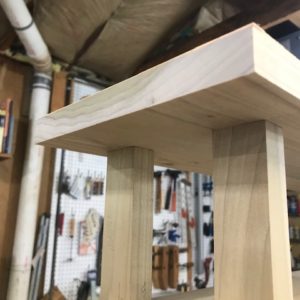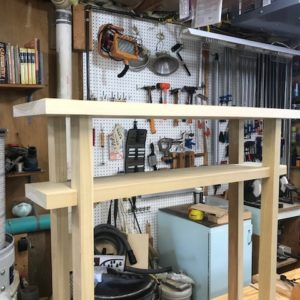I’m building a small hall table for my oldest daughter out of poplar (she insists she’s going to paint it). Pics below – taken from a design she saw / likes online.
The top is a solid board, 8 inches wide. The front to back span between the legs is 5 inches (inside). Plan B was to tenon stretchers into the top of the legs (front to back) just under the top and screwing the top from below to the stretchers but fear it will impact the design / appearance.
To maintain the “clean” underside look I’m now thinking about simply attaching the top with blind dowels (not through the top) to the legs but am wondering about movement. The table will be indoors – heated and airconditioned year round. My original Plan A was to attach the legs with blind mortices into the top and forming tenons on the top of the legs but walked away from that for fear of later movement in the top. I could recut the legs, but if the potential movement isn’t an issue, then I might just as well dowel the top at this stage.
Any thoughts / ideas / alternatives appreciated.

















Replies
Well one thing is for sure... that board is gonna move. That's a honkin' piece of lumber. Looks to be what, 1 1/2 " thick? However, another question would be did you leave any room for that middle shelf to move?? It looks to be the same size as the top?
nevertheless, the first ideas that pop into mind...
Make some nice little wooden buttons to attach from the leg to top. Screwed to the top with a lip going into a slotted groove where it will hold it down but slide across as the wood moves. You can make them look pretty decent and incorporate it into the design.
If you're stuck on showing nothing, tenons would be the ideal way to do this, but you could get your self a thick dowel or series of smaller ones. Make your tenons and mortises, then just glue the back legs in. Make the front mortises long so there is room to expand and contract in the front. This would give you the look your after while firmly attaching the top while still allowing for some movement.
If the moisture changes cause the top to expand widthwards, the shelf should expand the same amount. The legs look like their grain is in the same orientation width-wise as the grain of the top and shelf too ..... So expansion-contraction across the grain shouldn't be a problem.
Dowels, though, might be. They're notorious for changing shape in a way different from the hole they're in. Even small moisture changes over the years eventually loosen the glue bond.
One remedy is to fox-wedge the dowel. A thin cut is made in the dowel ends into which is tapped a small thin wedge that sticks up out of the dowel end a little when it's pushed in by hand. When you force the dowels into their blind holes, the wedges are pushed further into the dowel-ends, which fattens both ends of the dowel in those holes.
The wood of the dowel - and perhaps that of the dowel hole too - gets compressed a bit. This helps stop the dowels going a bit slack with expansion-contraction over the seasons and years.
Lataxe
Good info. The top and lower shelf are 7/8” thick... just looks bigger because of the angle of the picture. The grain orientation of the legs and the top is the same, so I understand your response Lataxe.
The lower shelf is just half lapped with the legs. I didn’t think about that expansion. The half laps are pretty snug so my plan was to rely solely on glue.
I think I understand the buttons. I’ve used metal top clips in the past but they’ve been hidden by the skirt. No skirt here... wood buttons may just gimme me the fastener I’m looking for.
The distance between the points of connection of the legs to the top and the bottom shelf is approximately the same. Since the top and the bottom shelf are the same material and thickness, they will expand/contract about the same amount between those points. Go ahead and glue the bottom shelf into the leg notches and fasten the legs to the top with dowels. All will be well.
If you use dowels:
Larger dowels that are made with a pair of matched cutters (dowel-maker and forstner bit) will give a better fit and longer term grip. Big dowels are also easier to fox-wedge.
Consider also making the top dowel holes through-holes so the dowel-ends show on the table top surface. This also allows you to make the top hole very slightly oval so that a wedge banged in to the dowel end (like the wedges of through wedged tenons) will improve the grip of the dowel mechanically and also look decorative, especially if the wedge is a contrasting timber.
Buttons.
The table has a solid, muscular and slightly over-engineered look that is appealing. If you made large rectilinear buttons in the same style, that could blend the buttons with the design of the table. They would be a show item rather than a hidden thing behind the aprons, as you don't have aprons on that design.
The "rectilinear style" could be bars of, say, 2" x 2" of 3-4" in length, with a tab at one end to fit in matching slots in the table legs. As the top won't move significantly with reference to the legs, the tabs and slots to take them could be a tightish fit, rather than the slot being wider than the tab to allow movement.
Four big buttons running parallel to the long edge of the table top, on the outside of the legs, might look quite good ......? Perhaps they could come to the tabletop ends and have a chamfer on their free ends? Their job would be just to keep the table top in place on it's undercarriage. .... And to be decorative.
The buttons would need to be of the same timber and be well finished & fitted to look right. In some ways, it might be a case of the bigger the better.
Lataxe
If no one is going to be looking at it from underneath I would use figure 8 connectors. I would use them even if they were going to be looking. Building for movement is so much easier than repairing.
Thanks all for your input. Plenty of good food for thought. GeeDubBee, I've seen the figure 8 fastners before but had forgotten about them - never used them.
This forum post is now archived. Commenting has been disabled